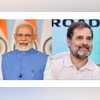For India, the year 2024 was as remarkable as it was surprising in the world of politics. The world’s largest democracy successfully conducted the Assembly elections in Jammu and Kashmir for the first time since the abrogation of Article 370. The states of Andhra Pradesh, Odisha, Haryana, Maharashtra, and Jharkhand also went to the polls.
However, the key highlight of the election year remained the general elections and their aftermath, which not only reshaped Indian politics but also compelled political thinkers to offer new explanations for evolving electoral behaviour.
Let’s look at the major political events of 2024 that (re)shaped India’s electoral landscape for the future.
Lok Sabha Polls: NDA wins, INDIA bloc grows
Although the BJP’s highly ambitious goal of ‘abki baar, 400 paar’ (this time, 400+ seats for the NDA) received a reality check from the public, with its tally restricted to 240 seats, the saffron party formed the government for a third time with the support of NDA allies, securing a total of 293 seats. The poll results were a delight for the INDIA bloc, particularly the Congress, as it got the opportunity to appoint its Leader of Opposition (LoP) for the first time in a decade.
The outcome was surprising as it defied all exit polls, which had predicted a thumping majority for the ruling BJP. It was also the first time that Prime Minister Narendra Modi led a government without a clear majority.
With the BJP now dependent on key allies like the Janata Dal (United) (JD-U) in Bihar and the Telugu Desam Party (TDP) in Andhra Pradesh, experts predict potential roadblocks for the BJP in fulfilling key agendas such as the Uniform Civil Code (UCC) and the Waqf (Amendment) Bill.
More From This Section
Haryana: Congress hopes shattered; BJP charged up
After the Lok Sabha polls, the election outcome in Haryana emerged as one of the most defining features of Indian politics in 2024. Banking on farmers’ protests, wrestlers’ protests, and resentment against the Agniveer scheme, the Congress hoped for a comfortable victory in the assembly elections.
However, the BJP, through leadership changes in the state government and a calculated balancing of caste arithmetic in ticket distribution, not only achieved a clear majority but also surpassed its previous record of 47 seats (2014) by winning 48 seats in 2024. Business Standard earlier analysed how the BJP overcame caste barriers to secure this victory.
The poll outcome not only dashed the Congress’ hopes of reviving its glory days but also demoralised its cadre, particularly in Maharashtra.
Maharashtra poll outcome: ‘Samandar laut aaya’
The 127-second viral video of Devendra Fadnavis reciting a couplet—‘Mera paani utarte dekh, kinaare par ghar mat bana lena, main samandar hun, laut kar vapis aaunga’ (Thinking the tide has ebbed, don’t you dare build your house on the coast; for I am the sea, and I will return)—captured public attention as he took oath as the Chief Minister for a third time.
The high-stakes political battle in Maharashtra was not just a fight between the BJP and the Congress but also a contest of ‘asli-nakli’ within the NCP (NCP vs NCP-SP) and the Shiv Sena (Shiv Sena vs Shiv Sena-UBT).
In this prestigious contest, Eknath Shinde-led Shiv Sena won 57 assembly seats, while Uddhav Thackeray’s faction was limited to 20 seats, half of which were concentrated in the Mumbai region. Meanwhile, Ajit Pawar’s NCP outperformed Sharad Pawar’s faction, winning 41 seats and restricting the senior Pawar to just 10 seats.
Hemant Soren makes a comeback, Patnaik leaves a legacy
After spending nearly five months in jail in a money laundering case, Jharkhand Mukti Morcha (JMM) leader Hemant Soren led his alliance to a victory, securing 56 out of 81 seats. Soren, along with his wife Kalpana, addressed around 200 rallies, consistently claiming that his arrest was politically motivated.
In Odisha, after 24 years of uninterrupted rule, the Biju Janata Dal (BJD) not only lost its majority in the state elections but also failed to win a single seat in the Lok Sabha polls. The outcome was a significant blow to its leader, Naveen Patnaik, who had ruled the state for over two decades due to his welfare and social security schemes. The BJP formed the government in Odisha, with Mohan Charan Majhi becoming the state’s first BJP chief minister.
South India: ‘Babu’ returns in Andhra; ‘son’ rises in Tamil Nadu
Telugu Desam Party (TDP) leader N Chandrababu Naidu became Andhra Pradesh chief minister for the fourth time by securing 135 out of 175 Assembly seats. Naidu’s TDP handed a crushing defeat to YS Jagan Mohan Reddy’s YSR Congress Party, which was reduced to just 10 seats. The TDP is now part of the BJP-led NDA, alongside Pawan Kalyan’s Jana Sena Party (JSP).
In Tamil Nadu, Udhayanidhi Stalin, the 45-year-old son of Chief Minister MK Stalin, was elevated to the position of Deputy Chief Minister in September. Critics described this move as an example of dynastic politics, while supporters saw it as a natural progression for the actor-turned-politician.
In the recently held assembly session, this marked only the second time in Tamil Nadu’s history that a father and son were seated in the House as Chief Minister and Deputy Chief Minister. The first instance occurred in 2009, with M Karunanidhi and MK Stalin.
Experts argue that while MK Stalin had to wait 12 years to transition from Deputy CM to CM, Udhayanidhi Stalin’s ascent to the top post could be quicker if the DMK wins the next assembly elections.

)